Blood Glucose Regulation Report: Analysis of Insulin and Glucagon
VerifiedAdded on 2023/05/30
|6
|1082
|476
Report
AI Summary
This report provides a detailed analysis of blood glucose regulation, focusing on the physiological actions of insulin and the role of glucagon. The report evaluates three exemplars (A, B, and C) based on their oral glucose tolerance test results, assigning scores and explaining the rationale behind them. It explores the correct physiological actions of insulin, highlighting its secretion by beta cells in the pancreas and its binding to glycoprotein receptors. Furthermore, the report examines the role of glucagon in regulating blood glucose levels, including its production in the islets of Langerhans and its effects on the liver and fat metabolism. The report also discusses the importance of peer-reviewed journal articles as reliable sources and explains the concept of the p-value and its interpretation in t-tests. The report also identifies missing elements in an exemplar and interprets a paired t-test result, concluding that the blood glucose level has not increased based on the p-value.
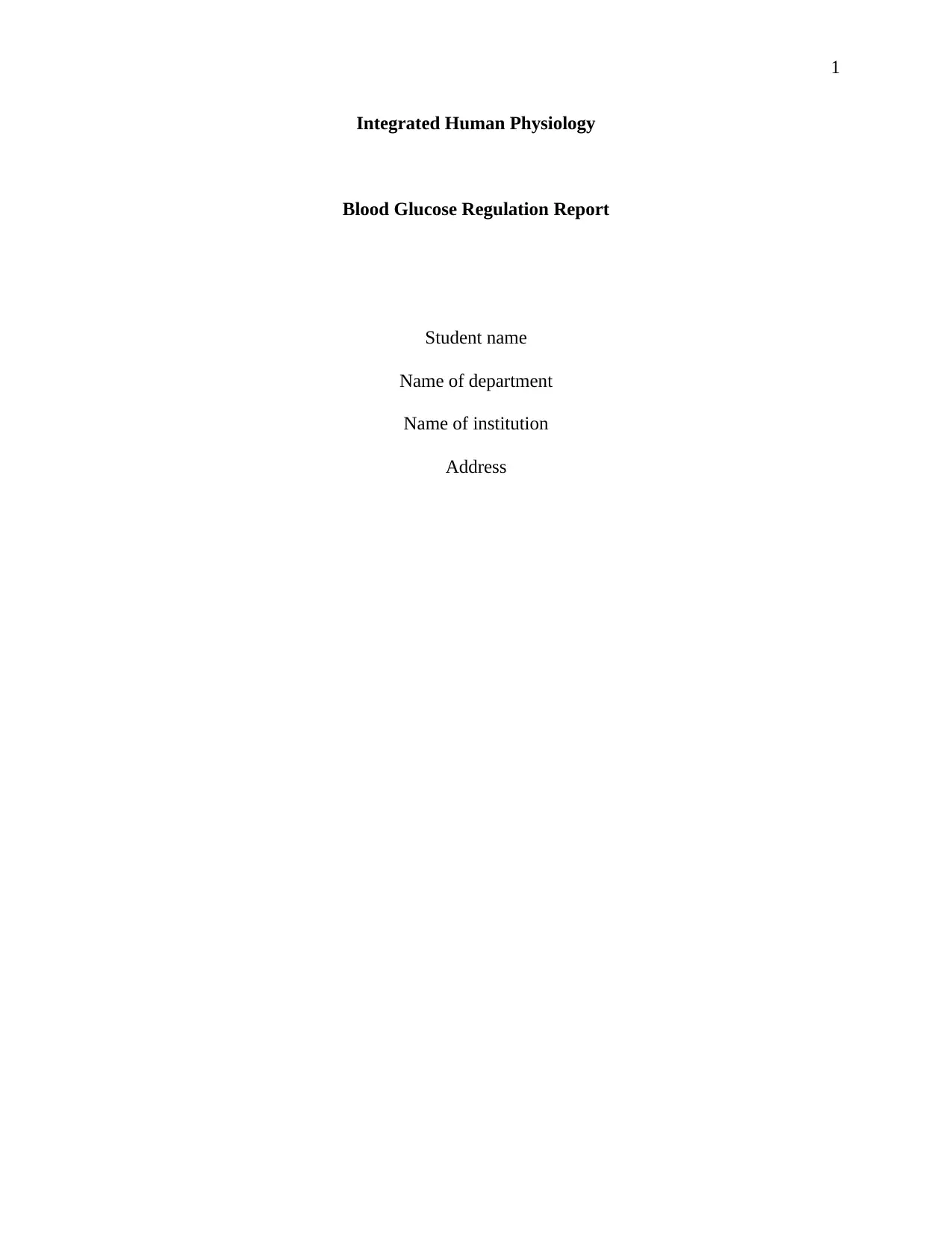
1
Integrated Human Physiology
Blood Glucose Regulation Report
Student name
Name of department
Name of institution
Address
Integrated Human Physiology
Blood Glucose Regulation Report
Student name
Name of department
Name of institution
Address
Paraphrase This Document
Need a fresh take? Get an instant paraphrase of this document with our AI Paraphraser
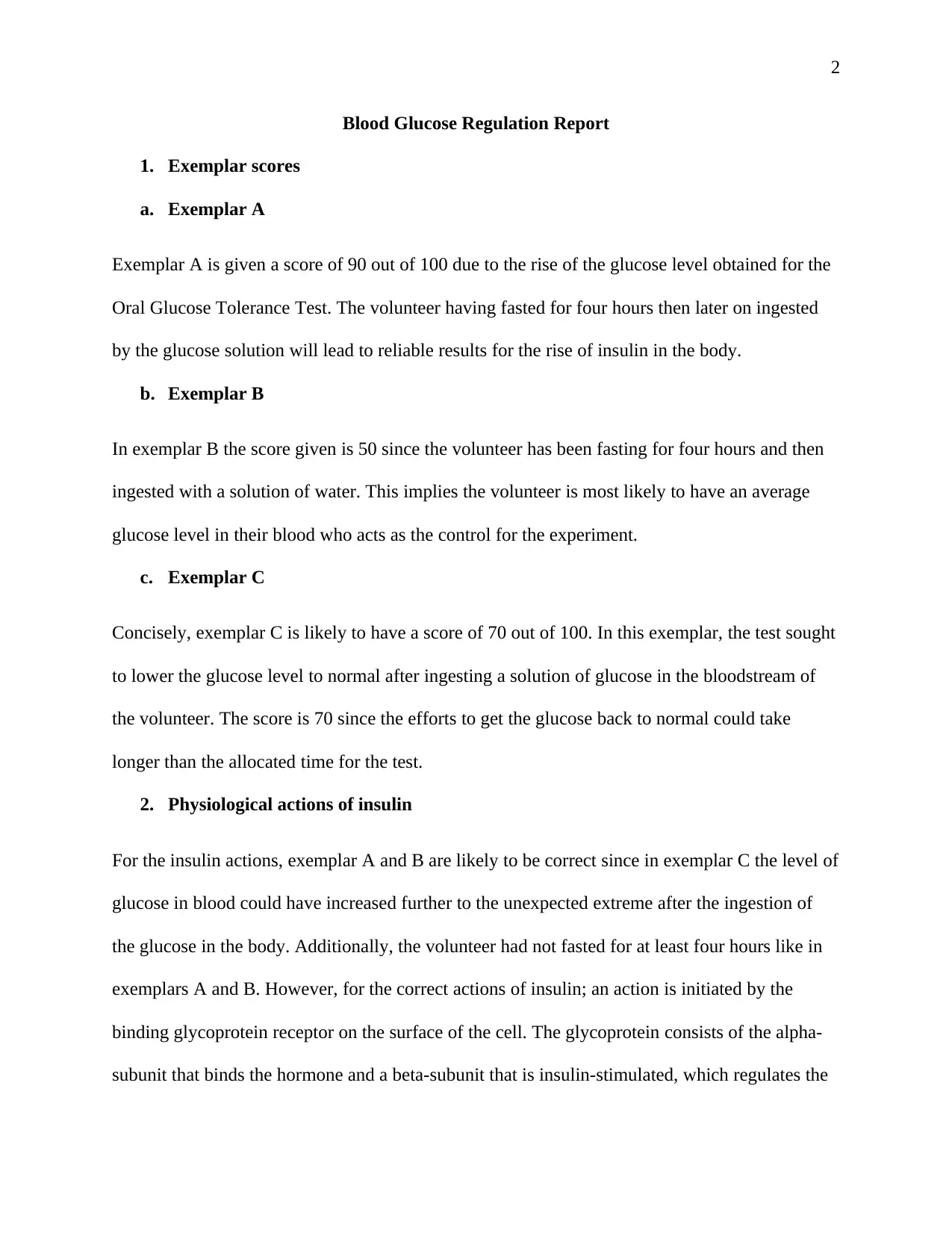
2
Blood Glucose Regulation Report
1. Exemplar scores
a. Exemplar A
Exemplar A is given a score of 90 out of 100 due to the rise of the glucose level obtained for the
Oral Glucose Tolerance Test. The volunteer having fasted for four hours then later on ingested
by the glucose solution will lead to reliable results for the rise of insulin in the body.
b. Exemplar B
In exemplar B the score given is 50 since the volunteer has been fasting for four hours and then
ingested with a solution of water. This implies the volunteer is most likely to have an average
glucose level in their blood who acts as the control for the experiment.
c. Exemplar C
Concisely, exemplar C is likely to have a score of 70 out of 100. In this exemplar, the test sought
to lower the glucose level to normal after ingesting a solution of glucose in the bloodstream of
the volunteer. The score is 70 since the efforts to get the glucose back to normal could take
longer than the allocated time for the test.
2. Physiological actions of insulin
For the insulin actions, exemplar A and B are likely to be correct since in exemplar C the level of
glucose in blood could have increased further to the unexpected extreme after the ingestion of
the glucose in the body. Additionally, the volunteer had not fasted for at least four hours like in
exemplars A and B. However, for the correct actions of insulin; an action is initiated by the
binding glycoprotein receptor on the surface of the cell. The glycoprotein consists of the alpha-
subunit that binds the hormone and a beta-subunit that is insulin-stimulated, which regulates the
Blood Glucose Regulation Report
1. Exemplar scores
a. Exemplar A
Exemplar A is given a score of 90 out of 100 due to the rise of the glucose level obtained for the
Oral Glucose Tolerance Test. The volunteer having fasted for four hours then later on ingested
by the glucose solution will lead to reliable results for the rise of insulin in the body.
b. Exemplar B
In exemplar B the score given is 50 since the volunteer has been fasting for four hours and then
ingested with a solution of water. This implies the volunteer is most likely to have an average
glucose level in their blood who acts as the control for the experiment.
c. Exemplar C
Concisely, exemplar C is likely to have a score of 70 out of 100. In this exemplar, the test sought
to lower the glucose level to normal after ingesting a solution of glucose in the bloodstream of
the volunteer. The score is 70 since the efforts to get the glucose back to normal could take
longer than the allocated time for the test.
2. Physiological actions of insulin
For the insulin actions, exemplar A and B are likely to be correct since in exemplar C the level of
glucose in blood could have increased further to the unexpected extreme after the ingestion of
the glucose in the body. Additionally, the volunteer had not fasted for at least four hours like in
exemplars A and B. However, for the correct actions of insulin; an action is initiated by the
binding glycoprotein receptor on the surface of the cell. The glycoprotein consists of the alpha-
subunit that binds the hormone and a beta-subunit that is insulin-stimulated, which regulates the
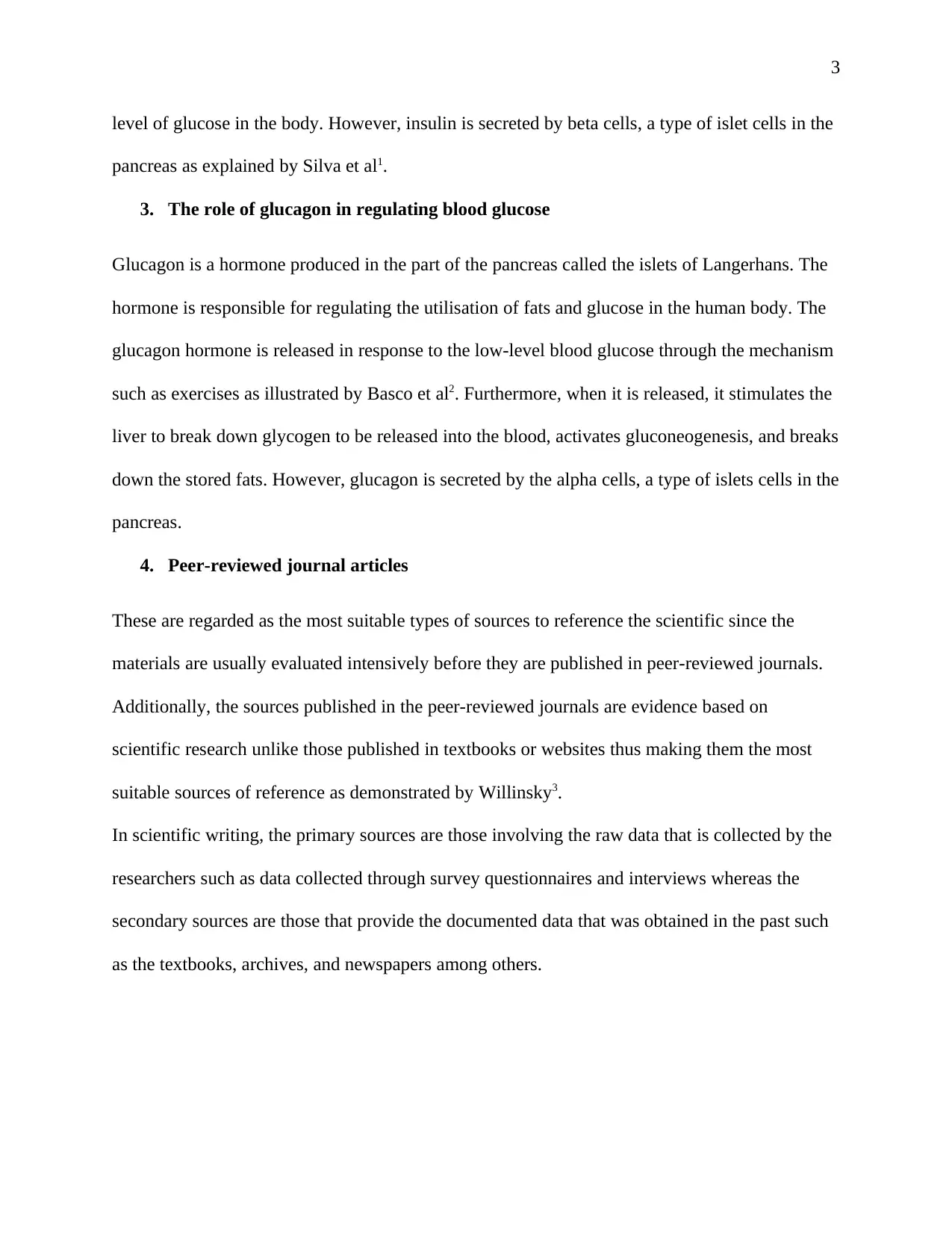
3
level of glucose in the body. However, insulin is secreted by beta cells, a type of islet cells in the
pancreas as explained by Silva et al1.
3. The role of glucagon in regulating blood glucose
Glucagon is a hormone produced in the part of the pancreas called the islets of Langerhans. The
hormone is responsible for regulating the utilisation of fats and glucose in the human body. The
glucagon hormone is released in response to the low-level blood glucose through the mechanism
such as exercises as illustrated by Basco et al2. Furthermore, when it is released, it stimulates the
liver to break down glycogen to be released into the blood, activates gluconeogenesis, and breaks
down the stored fats. However, glucagon is secreted by the alpha cells, a type of islets cells in the
pancreas.
4. Peer-reviewed journal articles
These are regarded as the most suitable types of sources to reference the scientific since the
materials are usually evaluated intensively before they are published in peer-reviewed journals.
Additionally, the sources published in the peer-reviewed journals are evidence based on
scientific research unlike those published in textbooks or websites thus making them the most
suitable sources of reference as demonstrated by Willinsky3.
In scientific writing, the primary sources are those involving the raw data that is collected by the
researchers such as data collected through survey questionnaires and interviews whereas the
secondary sources are those that provide the documented data that was obtained in the past such
as the textbooks, archives, and newspapers among others.
level of glucose in the body. However, insulin is secreted by beta cells, a type of islet cells in the
pancreas as explained by Silva et al1.
3. The role of glucagon in regulating blood glucose
Glucagon is a hormone produced in the part of the pancreas called the islets of Langerhans. The
hormone is responsible for regulating the utilisation of fats and glucose in the human body. The
glucagon hormone is released in response to the low-level blood glucose through the mechanism
such as exercises as illustrated by Basco et al2. Furthermore, when it is released, it stimulates the
liver to break down glycogen to be released into the blood, activates gluconeogenesis, and breaks
down the stored fats. However, glucagon is secreted by the alpha cells, a type of islets cells in the
pancreas.
4. Peer-reviewed journal articles
These are regarded as the most suitable types of sources to reference the scientific since the
materials are usually evaluated intensively before they are published in peer-reviewed journals.
Additionally, the sources published in the peer-reviewed journals are evidence based on
scientific research unlike those published in textbooks or websites thus making them the most
suitable sources of reference as demonstrated by Willinsky3.
In scientific writing, the primary sources are those involving the raw data that is collected by the
researchers such as data collected through survey questionnaires and interviews whereas the
secondary sources are those that provide the documented data that was obtained in the past such
as the textbooks, archives, and newspapers among others.
⊘ This is a preview!⊘
Do you want full access?
Subscribe today to unlock all pages.

Trusted by 1+ million students worldwide
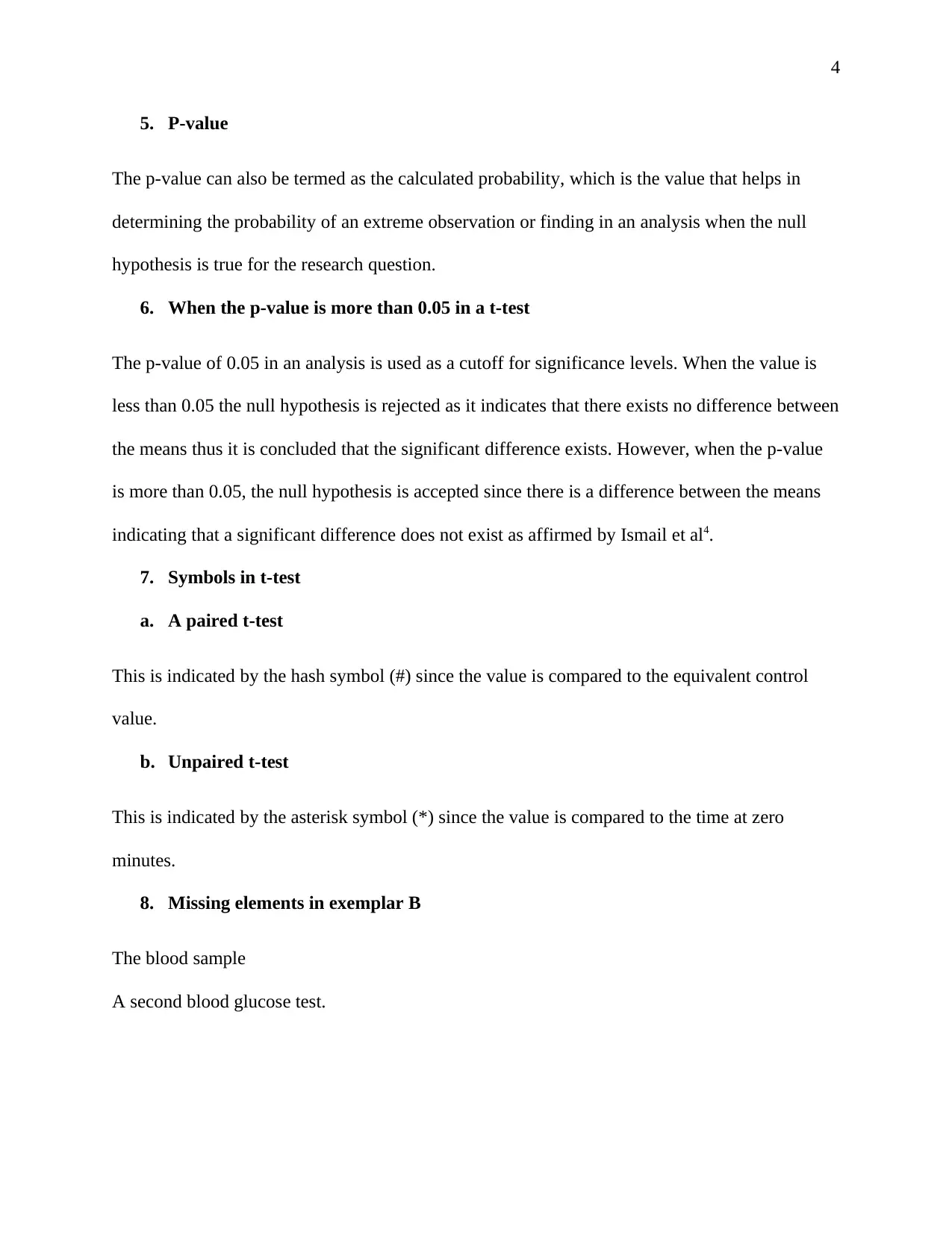
4
5. P-value
The p-value can also be termed as the calculated probability, which is the value that helps in
determining the probability of an extreme observation or finding in an analysis when the null
hypothesis is true for the research question.
6. When the p-value is more than 0.05 in a t-test
The p-value of 0.05 in an analysis is used as a cutoff for significance levels. When the value is
less than 0.05 the null hypothesis is rejected as it indicates that there exists no difference between
the means thus it is concluded that the significant difference exists. However, when the p-value
is more than 0.05, the null hypothesis is accepted since there is a difference between the means
indicating that a significant difference does not exist as affirmed by Ismail et al4.
7. Symbols in t-test
a. A paired t-test
This is indicated by the hash symbol (#) since the value is compared to the equivalent control
value.
b. Unpaired t-test
This is indicated by the asterisk symbol (*) since the value is compared to the time at zero
minutes.
8. Missing elements in exemplar B
The blood sample
A second blood glucose test.
5. P-value
The p-value can also be termed as the calculated probability, which is the value that helps in
determining the probability of an extreme observation or finding in an analysis when the null
hypothesis is true for the research question.
6. When the p-value is more than 0.05 in a t-test
The p-value of 0.05 in an analysis is used as a cutoff for significance levels. When the value is
less than 0.05 the null hypothesis is rejected as it indicates that there exists no difference between
the means thus it is concluded that the significant difference exists. However, when the p-value
is more than 0.05, the null hypothesis is accepted since there is a difference between the means
indicating that a significant difference does not exist as affirmed by Ismail et al4.
7. Symbols in t-test
a. A paired t-test
This is indicated by the hash symbol (#) since the value is compared to the equivalent control
value.
b. Unpaired t-test
This is indicated by the asterisk symbol (*) since the value is compared to the time at zero
minutes.
8. Missing elements in exemplar B
The blood sample
A second blood glucose test.
Paraphrase This Document
Need a fresh take? Get an instant paraphrase of this document with our AI Paraphraser
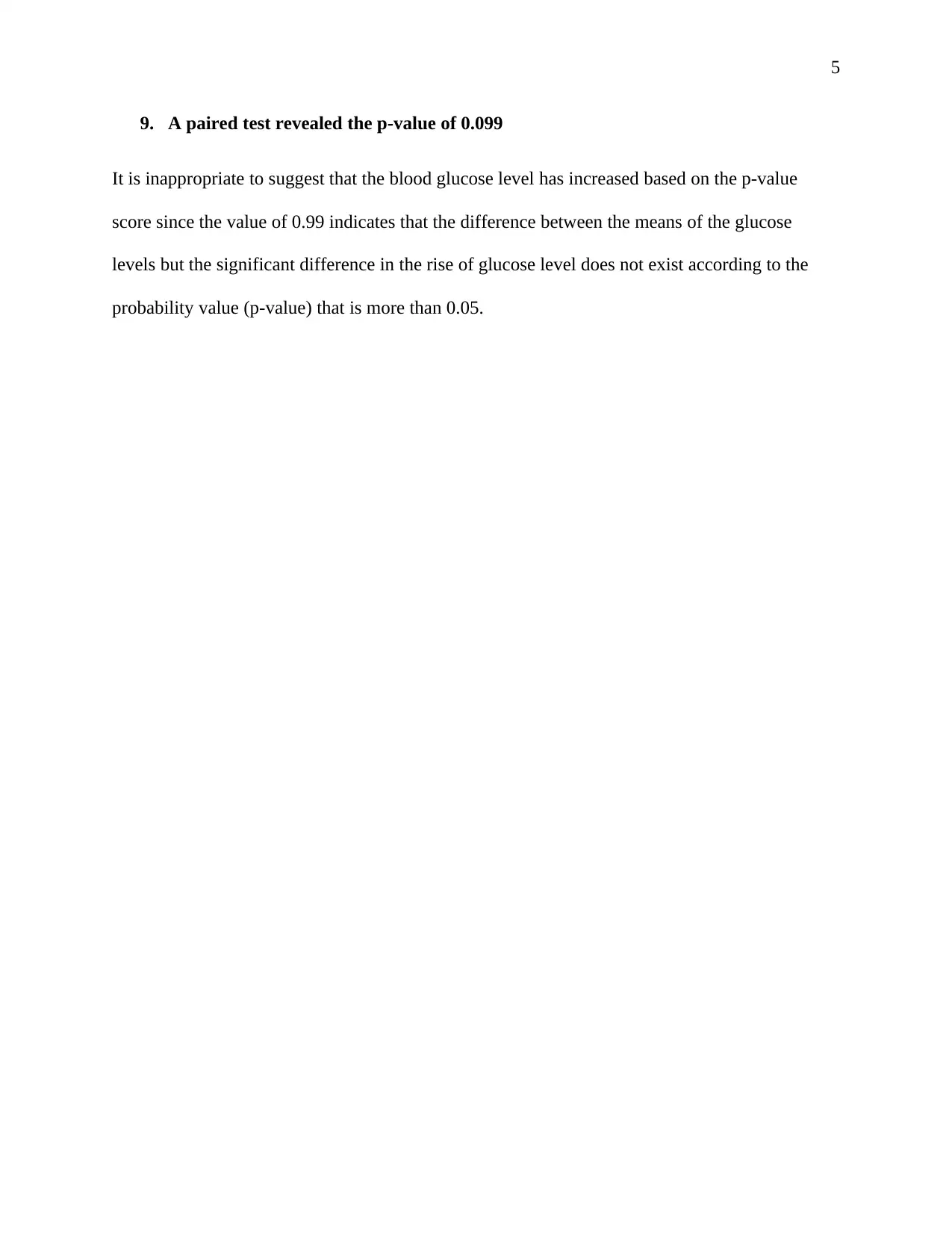
5
9. A paired test revealed the p-value of 0.099
It is inappropriate to suggest that the blood glucose level has increased based on the p-value
score since the value of 0.99 indicates that the difference between the means of the glucose
levels but the significant difference in the rise of glucose level does not exist according to the
probability value (p-value) that is more than 0.05.
9. A paired test revealed the p-value of 0.099
It is inappropriate to suggest that the blood glucose level has increased based on the p-value
score since the value of 0.99 indicates that the difference between the means of the glucose
levels but the significant difference in the rise of glucose level does not exist according to the
probability value (p-value) that is more than 0.05.
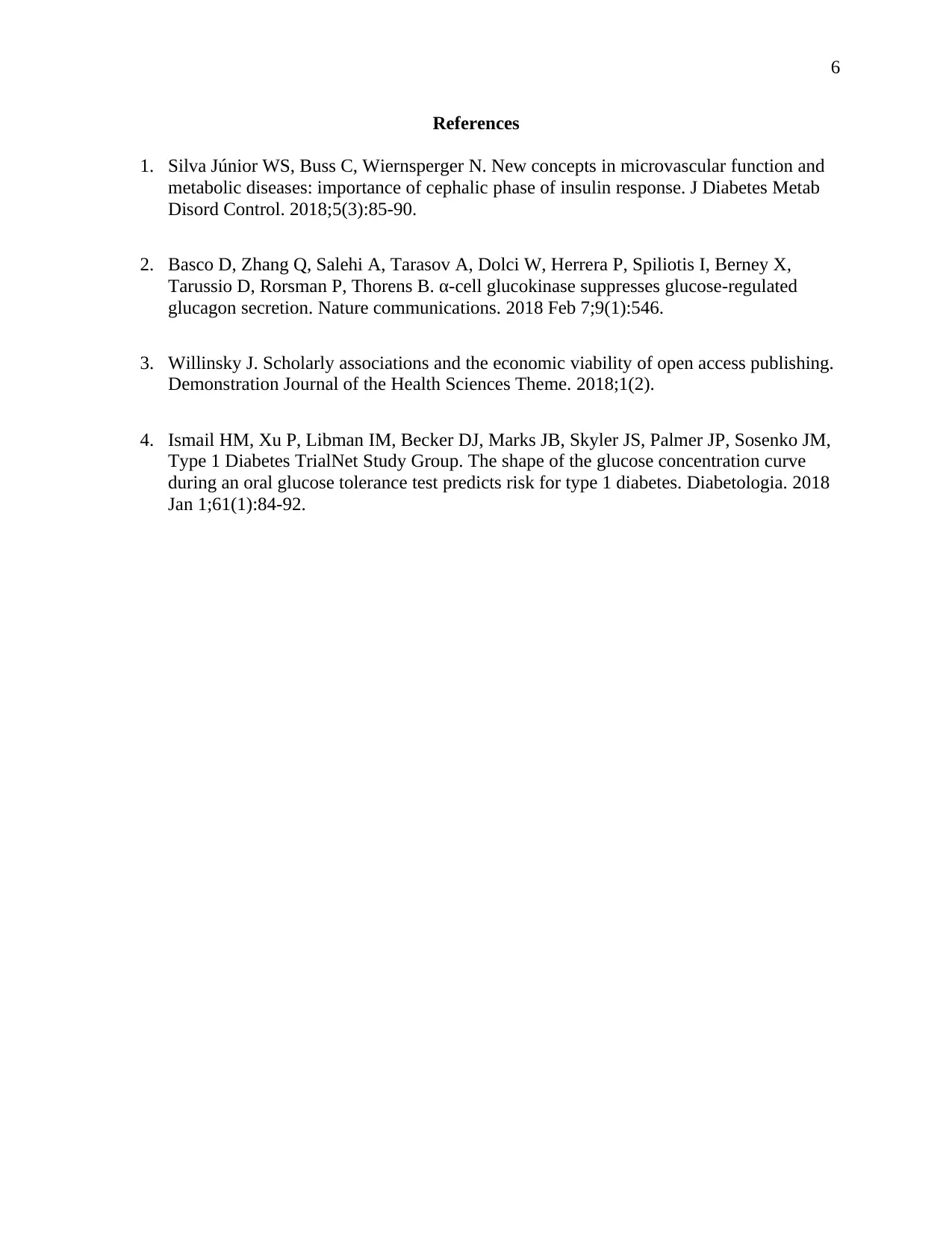
6
References
1. Silva Júnior WS, Buss C, Wiernsperger N. New concepts in microvascular function and
metabolic diseases: importance of cephalic phase of insulin response. J Diabetes Metab
Disord Control. 2018;5(3):85-90.
2. Basco D, Zhang Q, Salehi A, Tarasov A, Dolci W, Herrera P, Spiliotis I, Berney X,
Tarussio D, Rorsman P, Thorens B. α-cell glucokinase suppresses glucose-regulated
glucagon secretion. Nature communications. 2018 Feb 7;9(1):546.
3. Willinsky J. Scholarly associations and the economic viability of open access publishing.
Demonstration Journal of the Health Sciences Theme. 2018;1(2).
4. Ismail HM, Xu P, Libman IM, Becker DJ, Marks JB, Skyler JS, Palmer JP, Sosenko JM,
Type 1 Diabetes TrialNet Study Group. The shape of the glucose concentration curve
during an oral glucose tolerance test predicts risk for type 1 diabetes. Diabetologia. 2018
Jan 1;61(1):84-92.
References
1. Silva Júnior WS, Buss C, Wiernsperger N. New concepts in microvascular function and
metabolic diseases: importance of cephalic phase of insulin response. J Diabetes Metab
Disord Control. 2018;5(3):85-90.
2. Basco D, Zhang Q, Salehi A, Tarasov A, Dolci W, Herrera P, Spiliotis I, Berney X,
Tarussio D, Rorsman P, Thorens B. α-cell glucokinase suppresses glucose-regulated
glucagon secretion. Nature communications. 2018 Feb 7;9(1):546.
3. Willinsky J. Scholarly associations and the economic viability of open access publishing.
Demonstration Journal of the Health Sciences Theme. 2018;1(2).
4. Ismail HM, Xu P, Libman IM, Becker DJ, Marks JB, Skyler JS, Palmer JP, Sosenko JM,
Type 1 Diabetes TrialNet Study Group. The shape of the glucose concentration curve
during an oral glucose tolerance test predicts risk for type 1 diabetes. Diabetologia. 2018
Jan 1;61(1):84-92.
⊘ This is a preview!⊘
Do you want full access?
Subscribe today to unlock all pages.

Trusted by 1+ million students worldwide
1 out of 6
Related Documents
Your All-in-One AI-Powered Toolkit for Academic Success.
+13062052269
info@desklib.com
Available 24*7 on WhatsApp / Email
![[object Object]](/_next/static/media/star-bottom.7253800d.svg)
Unlock your academic potential
Copyright © 2020–2025 A2Z Services. All Rights Reserved. Developed and managed by ZUCOL.





